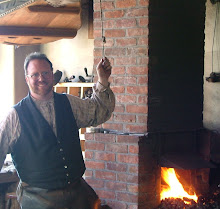Every day in Field's Blacksmith shop starts with making a fire. Today most people use newspaper to start their kindling. I like to use birch bark. When we have birch firewood I break off the bark and save it.
It can also be found in the woods when a birch has fallen and rotten on the forest floor. Even when the wood has decayed the bark is still intact and useable. Don’t peel bark from live trees as it can kill them. There is plenty available from dead trees.
Birch bark is touch and contains natural oils and resins to protect the tree. Those same oils and resins make it an excellent fire starter. A small piece will make a big flame and burn for a minute or more. I use it to start my kindling wood.
I use it to start my kindling wood.
 Once the kindling is burning well I add coke and get the fire burning bright.
Once the kindling is burning well I add coke and get the fire burning bright.
It can also be found in the woods when a birch has fallen and rotten on the forest floor. Even when the wood has decayed the bark is still intact and useable. Don’t peel bark from live trees as it can kill them. There is plenty available from dead trees.
Birch bark is touch and contains natural oils and resins to protect the tree. Those same oils and resins make it an excellent fire starter. A small piece will make a big flame and burn for a minute or more.
 I use it to start my kindling wood.
I use it to start my kindling wood. Once the kindling is burning well I add coke and get the fire burning bright.
Once the kindling is burning well I add coke and get the fire burning bright.
 At the blacksmith shop we are finally finishing repairs to the 1830’s plow. It has new nuts, bolts, brackets, and will be getting a coulter knife. The oxen will get to use it in the spring.
At the blacksmith shop we are finally finishing repairs to the 1830’s plow. It has new nuts, bolts, brackets, and will be getting a coulter knife. The oxen will get to use it in the spring. 




 Forge out a taper to make one of the wings. I forged mine to 4 inches, about the width of my anvil. It is often useful to use the anvil as a measuring device. Then start the other end, leaving enough material for the nut between the two scrolled ends. I left about 1 1/2 of material.
Forge out a taper to make one of the wings. I forged mine to 4 inches, about the width of my anvil. It is often useful to use the anvil as a measuring device. Then start the other end, leaving enough material for the nut between the two scrolled ends. I left about 1 1/2 of material. Make the ram’s horns by rolling the end like a cinnamon roll. I do it by forging it tightly over the edge of the anvil. Scroll it like the first.
Make the ram’s horns by rolling the end like a cinnamon roll. I do it by forging it tightly over the edge of the anvil. Scroll it like the first. 


